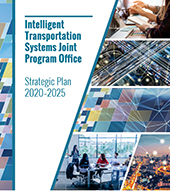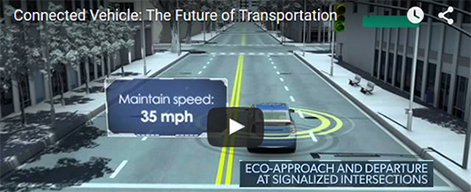About ITS JPO
Advisory Memo to USDOT #2 - October 31, 2008
Introduction
On July 31 st and August 1 st 2008 the ITS Program Advisory Committee (ITSPAC) met at the Marriott Courtyard near USDOT HQ in Washington, DC. Minutes and supporting documents from the meeting have already been distributed by JPO staff. This memo was prepared by Joseph Sussman (chair) and Robert Denaro (co-chair) and vetted by the committee; it constitutes the committee’s considered views and advice to the USDOT with respect to ITS and related programs.
The agenda to the meeting is attached. The chair, Joseph Sussman, conducted the first day’s agenda, and Robert Denaro, the vice chair, conducted the second day’s agenda. The committee wishes to thank those who presented to us. This included RITA Administrator Paul Brubaker, JPO director Shelley Row, Gary Ritter, Scott Belcher, President of ITS America, Linda Dodge, Steve Sill, Valerie Briggs, Paul Pisano, Brian Cronin, Yehuda Gross and Kate Hartman. All the presentations were useful and clear. The committee was able to get through a substantial amount of material in a relatively short period of time. The program staff is especially to be commended for its succinct descriptions of their program elements.
At this meeting, the committee devoted considerable attention to the ITS JPO goals, and a section below describes the committee’s perspectives on those goals and their appropriateness. Also considerable time was spent on the current ITS program and a section below discusses the committee’s views on the various projects contained therein. But before that, as context for those discussions to come, the committee first makes several general observations.
Observations
Future research advice
The current research program, including the following elements –
Next-Generation 9-1-1, Emergency Transportation Operations, Rural Safety, Integrated Vehicle-Based Safety Systems, Vehicle Infrastructure Integration Proof of Concept, Cooperative Intersection Collision Avoidance Systems, Clarus, Congestion Initiative, Intelligent Transportation Operation Testing to Mitigate Congestion, Integrated Corridor Management, Mobility Services for All Americans, and Electronic Freight Management
--is reviewed later in this document. It was characterized by JPO as, and indeed is, in its twilight period. The program is about to undergo a substantial transition, as research in the existing program elements reaches a close. For this reason the views of the advisory committee will, we hope, be especially useful in shaping the program of the future.
In particular, in the future the committee hopes to give useful advice on the question of gaps or “white space” in the research program. What areas are not being effectively pursued either by JPO or the community at large is something worth discussing. Some possible examples of “white space” include system management, ITS and the environment, transportation network management, the application of an overall engineering systems approach to ITS and the development of algorithms for network management. The committee noted the importance of understanding institutional barriers to deployment, and commented that issues such as congestion relief via ITS are perhaps no longer hardware problems; rather, effectively using the real-time data collected and overcoming institutional barriers to deployment may well be more important in improving congestion. The ITS research program should reflect that. The reauthorization of SAFETEA LU approaches and understanding how the ITS program fits within this new transportation legislation is important. So the “white space” question cited above is germane.
USDOT role in ITS research and development
Further, the appropriate federal role in ITS research and deployment needs to be well understood as the new legislation – which will contain the definition of the new ITS research directions – evolves. The committee noted the importance of USDOT as a leader on the transportation scene, and in ITS in particular. That is not to say that USDOT or the ITS JPO needs to dominate the ITS agenda; rather they can play an important role as facilitator, coordinator and shaper of the ITS program working together with their partners in the states and the private sector.
New York City ITS World Congress
The New York City ITS World Congress is on the immediate horizon. At the March meeting of the ITSPAC, some concern was raised about how ready the US is to present ITS demonstrations that show the value and importance of US-based ITS research and development. At the July/August meeting a considerable part of the agenda was devoted to hearing the plans of both USDOT and ITS America for their demonstrations. As a general proposition, we came away more comfortable that US work of value will be demonstrated at the World Congress in November 2008.
The committee noted the importance of properly dealing with the media at the World Congress. Having good demonstrations is of course a requirement, but properly packaging them for the media, especially in a major media center like New York City, is of great importance. The committee was assured that JPO and ITS America were fully cognizant of the importance of the media in the World Congress, and were taking appropriate steps to work effectively with them.
Linkage to University Transportation Centers Program
The committee restated its interest in having JPO cooperate with the universities funded by the University Transportation Centers (UTC) program of RITA. Upwards of 60 centers have been established around the country, many of which could greatly help in advancing the JPO ITS agenda. Outreach to those universities to achieve that end is important. While JPO has been working to build those linkages to UTC, this is perhaps going more slowly than we had hoped, and the committee urges JPO to expand and extend its efforts to build this potentially valuable partnership.
Committee Views on the Goals of the JPO ITS Program
In our ITSPAC meeting of July 31 – August 1, and especially on the first day, there was a good deal of active discussion on the question of goals for the ITS program with various views being expressed by the committee. The RITA perspective was to have a very strong focus on safety as the overarching goal of the ITS program, including an aggressive goal of reducing crashes by 90% by 2030. We agree that emphasizing a single goal provides focus and clarity, and safety appears to the committee to be an appropriate goal on which to focus.
At the same time, the committee notes that in its previous advisory committee memo, it urged a “systems approach” to ITS, noting that outcomes of the ITS programs at JPO occur on multiple dimensions.
“The committee sees the goals of the ITS program as being multidimensional. Those stated by JPO were mobility, safety, the environment………. and 21 st century institutions, innovations, and partnership. These goals reflect vital national transportation priorities—dealing with congestion, improving safety, environmental protection and enabling the deployment of new transportation technologies through institutional innovation.”
In addition, the committee suggested an additional goal:
“ITS-enabled Universal Access to the US Transportation System”
The proposed focus area under this goal is:
“Conduct research on and enable deployment of means by which all citizens can access the full mobility and information benefits of the US transportation system through ITS technologies”
Indeed it is hard to imagine a major transportation program – and ITS certainly fits that description – that does not take a multidimensional view of its outcomes. Sectary Peters’ recent statement about new ways of thinking about and conceptualizing the field of transportation mentions a number of goals – congestion, environmental, safety and others – and recognizes the vital need for improvements on all of these dimensions.
The attraction of the safety goal is that the other goals and objectives will virtually all contribute to safety. For example, reducing congestion is likely to reduce accidents as well. The reverse is also likely true. Improving mobility and environmental gains may well come about as a result of safety enhancements, particularly if efforts are directed towards advancing these goals together with attention to managing secondary impacts.
Therefore, while we agree the focus on safety is appropriate, we feel that these other goals should be acknowledged and treated explicitly, even if within the framework of the safety goal. More specifically, the ITS program should establish quantifiable levels of performance for these other goals – just as you have defined the 90% crash reduction goal for safety – and measure program performance over time. For example, the ITS program should identify the degree to which it might contribute to helping the U.S. transportation sector reduce greenhouse gas emissions by 2030 by increasing the efficiency of transportation networks and managing travel demand through pricing, enhanced modal options, and new traveler information and services. Other ITS technologies such as eco-driving may be of value as well and should have goals defined.
As for the RITA/JPO goal of a 90% reduction of crashes by 2030, this is clearly a bold statement with potential for catalyzing the agency and public and private participants. However, the committee would feel more comfortable if some analysis were done to establish the achievability of this goal, perhaps breaking it down into various ITS technologies with potential for reducing crashes and their contributions to the overall goal. It would be wise to identify needed R&D and a timeline of development and field deployment, with interim goals, to reach the eventual goal of 90%. This approach would validate the 90% goal and make it more credible. In addition, we stress the importance of a top-down systems engineering approach to analysis of the 90% goal, technologies and research available to attack the goal, and programs needed to move this goal toward reality.
Commentary on reaching the safety goal
The committee noted that because a large percentage of crashes and fatalities are due to driver behavior, we must address that behavior to approach this goal. A corollary of large-scale reduction in highway fatalities, therefore, would be “cars (vehicles) that can’t crash”. It is useful to address this concept and vision in terms of its constituent parts across the ITS program.
There are essentially four domains to ITS in a “car that can’t crash”. Referring to an earlier JPO concept of the 360 degree awareness car, the first domain is within the car, monitoring driver behavior. New technologies and data sources enable safety enhancements with speed limits, driver behavior measurement, eyelid movement, alcohol sensing and others.
The second domain is the “line-of-sight” domain, where “sight” could refer to any of a number of sensors including radar, lidar, video, infrared, etc. These sensors allow a car to sense objects and conditions around it. The auto industry is very actively researching and developing this technology, and the IVBSS Program is contributing to the technology in this domain.
The third domain is the “static far field” domain, the road ahead. Digital roadmaps can provide such static information as sharp curves, stop signs, steep inclines, known accident-prone locations, and other challenging driving conditions. Again, the IVBSS program touched on some of these attributes.
The fourth and final domain is the “dynamic far field” domain, changing conditions ahead. This might include low dynamic conditions such as construction zones or weather changes, or high dynamic conditions such as traffic accidents, other motor vehicles violating intersections, and pedestrians and bicyclists in and near the right-of-way. Clearly, this domain is the subject of the VII program and CICAS.
The point is that to achieve “cars that can’t crash”, and make feasible the goal of 90% reduction in crashes, these four domains about the car must be addressed in a seamless, highly integrated and complementary fashion. No single domain will accomplish the goal. We believe that this integrated concept is essential for addressing the safety goal of RITA/JPO.
The ideal federal role in reaching the safety goal
This leads to the question of the ideal role for the federal ITS Program in addressing the goal of 90% reduction in crashes. Should its approach to research, field operational tests, guidance and other contributions be identical in all of these four complementary domains? Our answer is clearly no. Private industry is developing in-vehicle technologies of the “line-of-sight” domain. Private industry, with some public-private partnership activity, is developing the “static far field” domain. And, because of the need for infrastructure, the USDOT has been driving the development of the “dynamic far field” domain with VII. However, we note that the USDOT has revised its approach to VII, acknowledging that the communications infrastructure may well be a mixture of government solutions, DSRC, and existing private communication channels. So this domain is becoming more of a public/private partnership as well.
However while ITS JPO’s research role may be limited in some domains, its leadership role remains. All parties, public or private, must adopt and focus on the 90% goal if it is to be achieved. JPO must provide leadership across all domains, whether the source of technology and development is private or public. The government must play a leadership role in working with the private sector in developing a roadmap for reaching the 2030 goal. And in the case of necessary technologies in which the private industry is not investing, then the government may need to invest more directly in the technology, such as VII.
Leadership can take many forms, including forums, initiatives, standards, institutional issues, legal issues, public awareness and academia involvement. Government rulemaking and tax incentives are tools that may be considered. In its leadership role, ITS JPO should consider all tools that can maximize the chances of success in developing and deploying the ITS technology that can create “cars that can’t crash” and achieving the bold safety goal articulated by RITA.
Committee Comments on Current ITS Programs
On the second day of the meeting, the JPO organized a high-level review of current programs and projects. The JPO asked for Committee responses to three questions for each of the projects:
- Are these current and future activities likely to advance either the state of the practice or state of the art in intelligent transportation systems?
- Are the technologies being researched and tested likely to be deployed by users? If not, what are the barriers to deployment?
- What are the appropriate roles for government and the private sector in investing in these existing and future research and technologies being considered?
A summary of the Committee’s comments is given below.
Next-Generation 9-1-1
Advance the State-of-the-Art?
This project should make significant contributions to upgrading and standardizing the public safety access point (PSAP) infrastructure.
Likely to Deploy and Barriers?
Deployment will depend heavily on buy-in by the States and local governments. The requirement for local funding to upgrade PSAPs is a significant barrier and could end up with a patchwork. It may be prudent to develop some kind of funding and program of Federal grants based on size of jurisdiction or other criteria.
Appropriate Government and Private Sector Roles?
Achieving standardized interoperability is a key government role and, if possible, funding support for PSAP upgrade and deployment management.
Emergency Transportation Operations
Advance the State-of-the-Art?
This was difficult for the Committee to assess since we only saw a narrow piece of the total program. It appears to be application of existing technology, however. There may be a need for standardization of technology implementing these features.
Likely to Deploy and Barriers?
Deployment is likely, but scalability issues may result in very regional deployment and there would not be a high probability of uniform nationwide deployment without additional incentive from the Federal Government.
Appropriate Government and Private Sector Roles?
Pursuing this technology for emergency operations is good fit for the government, and achieving interoperability is an important goal that would need Federal Government support.
Rural Safety
Advance the State-of-the-Art?
This program appears focused on application of mature technology, although that application is novel.
Likely to Deploy and Barriers?
It appears that the infrastructure investment required would be a challenge at the local level. For widespread deployment and consistency of implementation, some Federal program is probably needed.
Appropriate Government and Private Sector Roles?
Providing focus on rural issues is a good Federal role, but this initiative needs follow-op to encourage or subsidize deployment.
Integrated Vehicle-Based Safety Systems
Advance the State-of-the-Art?
The contributions of this project to the human interface issue and intersection of multiple warnings is a contribution of technology, but the basic technology for each of the warning systems is being worked on by the automotive industry, and the particular implementation of these subsystems in this project risk obsolescence over the duration of the project.
However, some of this technology is being worked by OEMs and suppliers, but speed of deployment is the issue that needs emphasis. This study could accelerate deployment.
Likely to Deploy and Barriers?
This technology is highly likely to deploy, but this USDOT project can play an important role in accelerating that deployment and moving toward standard fit on vehicles instead of the usual industry rollout of options on high-class vehicles. The industry needs guidance and leadership to move from the scattered application implementation that is happening today across automakers to a more consistent deployment for longitudinal and lateral control. Gathering data and statistics for NHTSA to review and supporting NCAP ratings are very important deployment catalysts, as well as rule making if safety improvements can be shown to be significant. These technologies can also support time-distance-place based pricing of road use which promises to reduce accidents, congestion, greenhouse gases, and other pollution.
Appropriate Government and Private Sector Roles?
The Committee believes that the USDOT should provide leadership and “show the way" to inform the public of the advantages of this technology and provide leadership to the auto industry. Current tools of NCAP ratings and rule-making are very important and effective roles for the government, when appropriate. The JPO should explore with NHTSA the potential of adopting rules to facilitate timely universal deployment of driver feedback and insurance pricing systems to advance national safety, energy conservation, and environmental goals as well as discouraging aggressive driving in favor of calm driving styles. The government may also play a role in reviewing systems, possibly including testing and certification.
Vehicle Infrastructure Integration Proof of Concept
Advance the State-of-the-Art?
While this program does not appear to be advancing the state-of-the-art specifically, USDOT’s leadership is significant in demonstrating proof-of-concept and dedicating frequency spectrum for this application. However, with the evolution of this concept to involve private telecommunication networks in addition to DSRC, the state-of-the-art is clearly in the private sector.
Likely to Deploy and Barriers?
Although VII is receiving significant attention by the USDOT and by industry, it is not clear at this point what the system and infrastructure might look like. The decision on the mix between government infrastructure (DSRC) and a common, standardized private infrastructure is critical to ensure interoperability and access for all. The challenge of investing in sufficient vehicle and roadside beacon penetration for the system to be effective appears daunting, so it is likely that satellite, cellular, Wi-Fi and/or other technologies will be required to play a large role. Efforts to develop a thorough system architectural strategy should be intensified in cooperation with key stakeholders. In addition, the Committee recommends additional work on the intersection of on-vehicle, autonomous technology and V2I or V2V. These systems are interrelated and should be addressed in an integrated fashion.
Appropriate Government and Private Sector Roles?
There is a difficult transition occurring of moving from a dedicated DSRC system to a hybrid of DSRC and private communications infrastructure. The government needs to provide leadership once again, possibly with standardization to achieve interoperability and the motivation for deployment. The United States is facing urgent problems of transportation system financing, greenhouse gas emissions, traffic safety, and congestion which universal VII system deployment could help address. USDOT should make it a high priority to convene key stakeholders in this arena to develop a national strategy for universal deployment of basic VII systems as needed to support effective time-distance-place based road pricing and system management, smart transit system management, real-time traveler information systems, and other VII applications across the nation in the coming decade.
Cooperative Intersection Collision Avoidance Systems
Advance the State-of-the-Art?
This application appears to advance the application of mature technology rather than state-of-the-art technology per se. However, this is an important application and in need of government leadership.
Likely to Deploy and Barriers?
CICAS could be a significant contributor to road safety. However, there is a challenge of identifying sufficient local funding for deployment and also of achieving standardization for interoperability across the nation. While the demonstrations of this technology are impressive, real-world conditions may limit the applications to only the most robust ones.
Appropriate Government and Private Sector Roles?
This is an appropriate effort for the government because it involves intersection infrastructure, which is unlikely to have sufficient private sector investment. In addition, the Federal Government must work with state and local agencies to achieve sufficient density of deployment to make a meaningful contribution to intersection safety.
Clarus
Advance the State-of-the-Art?
The application is promising, but appears to be an application of mature technology.
Likely to Deploy and Barriers?
This project faces the challenges of a lack of public awareness of the benefits and the regional deployment model. If the benefits to safety are realized only where weather-related accidents are a significant factor, then the actual number of avoided accidents may not be sufficient to justify local investment.
Appropriate Government and Private Sector Roles?
This is an appropriate role for the government, especially to manage the interfaces with NWS and NOAA.
Congestion Initiative, Intelligent Transportation Operation Testing to Mitigate Congestion
Advance the State-of-the-Art?
This project appears to be an application of existing technology with apparently good results.
Likely to Deploy?
As implemented by the current Administration, the program has aimed first and foremost to foster implementation of bundled strategies that simultaneously better manage, operate, and price existing road capacity while supporting improved public transportation options. By using a competitive incentive funding grant strategy, the initiative has spurred dozens of cities to advance proposals for such activities, with funding awarded to the most promising sites for near-term deployment. This is a useful model to spur innovation and should be replicated in other USDOT program activities.
Appropriate Government and Private Sector Roles?
This is an appropriate government role but it should be integrated with private sector solutions for parts of the problem as well. USDOT and Congress should consider strategies to foster more performance-based funding and performance-based contracting initiatives that build on and extend the model established by the Urban Partnership Program and Congestion Reduction Pilot Program elements of the USDOT Congestion Initiative.
Integrated Corridor Management
Advance the State-of-the-Art?
This project appears to use existing models with some level of integration and user interface and application.
Likely to Deploy and Barriers?
This program is focused on advancing an integrated set of best practice techniques into deployment in a number of regions, documenting performance and lessons learned. The general approaches from these pilot sites could be much more widely deployed in the future, with appropriate efforts to encourage and disseminate them.
Appropriate Government and Private Sector Roles?
This is an appropriate project for the government.
Mobility Services for All Americans
Advance the State-of-the-Art?
This project appears to bring existing technology to these groups who don't have it currently. It appears to be more of an administrative issue of managing vertical and horizontal activities within government. There is duplication in transportation services provided by different social service agencies. This project seeks to coordinate these services for much higher efficiency of transportation service delivery.
Likely to Deploy and Barriers?
There is a possibility for much more widespread deployment beyond the pilot sites, but this is likely only if there are clear requirements for social service transportation agencies to coordinate services. Such requirements could be created by Congressional or executive agency actions. Such coordination would improve the efficiency of use of scare funds and foster reduced dependence on imported oil, reduced pollution, and reduced greenhouse gas emissions.
Appropriate Government and Private Sector Roles?
This is an appropriate role. It is important to call on various government-funded social service and health agencies to better coordinate services and to hold them accountable for deployment of these coordination technologies and their success.
Electronic Freight Management
Advance the State-of-the-Art?
This project appears to be an application of existing technology.
Likely to Deploy and Barriers?
The deployment is most likely by private industry. The Federal Government needs a clear exit strategy for this project.
Appropriate Government and Private Sector Roles?
Attention to commercial transportation needs is important, so the government’s leadership here is warranted. However the government needs a defined exit strategy.
Conclusion
Again, the committee thanks the staff of JPO, as well as committee member Scott Belcher, President of ITS America, for preparing an excellent set of presentations in areas requested by the committee. We hope our observations and our critiques will be of value to ITS JPO and indeed the ITS community in general, and look forward to continuing our work and future opportunities to comment upon and advise JPO on its ITS programs.










